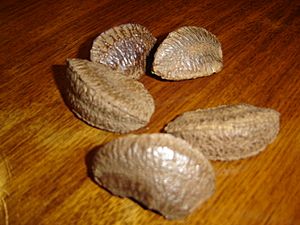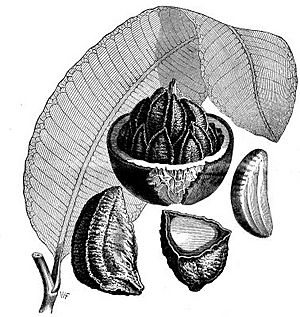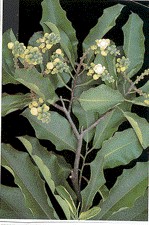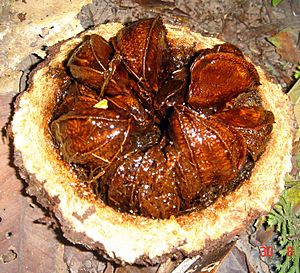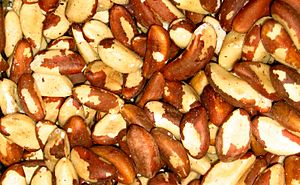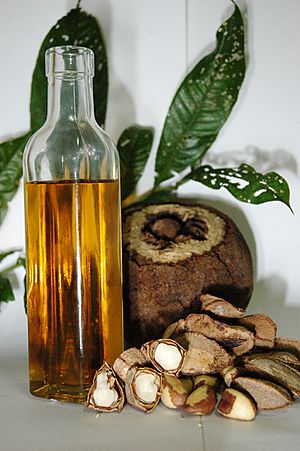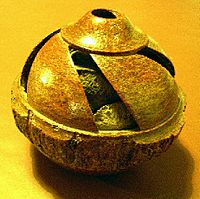Brazil nut facts for kids
Quick facts for kids Brazil nut tree |
|
|---|---|
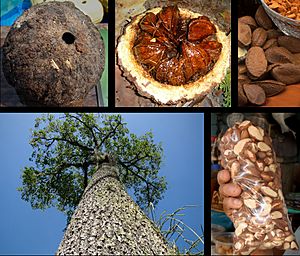 |
|
| Conservation status | |
| Scientific classification | |
| Genus: |
Bertholletia
|
| Species: |
excelsa
|
The Brazil nut (Bertholletia excelsa) is a large tree found in South America. It's also the name of the tasty seeds that are collected from this tree and sold. These trees are some of the biggest and oldest in the Amazon rainforest.
The fruit of the Brazil nut tree, which holds the edible nuts, is quite large. It can weigh up to 2 kilograms (about 4.4 pounds)! Brazil nuts are packed with important nutrients, especially a lot of selenium. The wood from the Brazil nut tree is also very good quality. It's used for things like flooring and building.
Contents
What are Brazil Nuts Called?
In different parts of South America, Brazil nuts have different names. In Spanish-speaking countries, they might be called castañas de Brasil or nuez de Brasil. In Brazil, people often just call them "castanha." Sometimes, they are called castanhas-do-pará, which means "chestnuts from Pará" (a state in Brazil).
About the Brazil Nut Tree
The Brazil nut tree is truly huge! It can grow up to 50 meters (about 164 feet) tall. Its trunk can be 1 to 2 meters (3 to 6.5 feet) wide. This makes it one of the largest trees in the Amazon rainforest. These trees can live for a very long time, often over 500 years, and some even reach 1,000 years old!
The tree's trunk is usually straight and doesn't have branches for a long way up. Its top branches spread out wide, rising above other trees in the forest. The bark is smooth and grayish. The leaves fall off during the dry season. They are large, about 20–35 cm (8–14 inches) long. The flowers are small and greenish-white.
Where Brazil Nuts Grow
Brazil nut trees are native to several countries in South America. These include the Guianas, Venezuela, Brazil, eastern Colombia, eastern Peru, and eastern Bolivia. You can find them scattered throughout large forests. They often grow along the banks of big rivers like the Amazon River and Orinoco.
Sometimes, you can even see these trees growing outside of the main forests. They might be in people's backyards or along roads in northern and northeastern Brazil. The fruit is heavy and hard. When it falls, it can be quite heavy.
How Brazil Nuts Reproduce
Brazil nut trees mostly produce fruit in untouched forests. This is because they need special large bees to pollinate their flowers. These bees, like bumblebees and other types, are the only ones strong enough to open the flowers and help them make fruit. Brazil nuts have been grown on farms, but they don't produce as many nuts, so it's not usually worth it.
It takes about 14 months for the fruit to grow after the flowers are pollinated. The fruit is a big, round pod, about 10–15 cm (4–6 inches) across. It looks a bit like a coconut and can weigh up to 2 kg (4.4 pounds). Inside, it has a very hard, woody shell. This shell holds 8 to 24 wedge-shaped seeds, which are the Brazil nuts we eat. They are packed inside like orange slices.
The fruit has a small hole at one end. This hole is important for animals like the agouti. Agoutis are rodents that can gnaw open the hard shell. They eat some of the nuts and bury others for later. Some of these buried nuts can then grow into new Brazil nut trees! Most seeds are "planted" by agoutis during the wet season. Young trees might stay small for years, waiting for an older tree to fall. This lets sunlight reach them, and then they start growing quickly. Capuchin monkeys have also been seen opening Brazil nuts using a stone as a tool.
Brazil Nuts and People
In Brazil, it is against the law to cut down a Brazil nut tree. This rule helps protect the trees and the forests where they grow. You need special permission from the government to cut one down.
How Brazil Nuts are Produced
| Brazil nut production – 2017 | |
|---|---|
| Country | (tonnes) |
|
|
|
|
|
|
|
|
|
|
|
|
|
|
|
|
|
|
In 2017, the world produced about 84,000 tonnes of Brazil nuts. Most of these nuts are collected from wild trees in the Amazon rainforest. This way of gathering nuts helps people earn money without destroying the forest. The people who collect the nuts are called castañeros (in Spanish) or castanheiros (in Portuguese).
However, cutting down trees for wood is a big problem for the Brazil nut industry. Studies show that if too many nuts are collected, not enough seeds are left to grow new trees. Areas where only a few nuts are gathered have many young trees. But places where a lot of nuts are collected have almost no young trees.
Rules for Importing Brazil Nuts
In 2003, the European Union made strict rules about importing Brazil nuts still in their shells. This is because the shells can sometimes have unsafe levels of aflatoxins. Aflatoxins are natural substances that can be harmful if eaten in large amounts.
Eating Brazil Nuts
| Nutritional value per 100 g (3.5 oz) | |
|---|---|
| Energy | 2,743 kJ (656 kcal) |
|
12.27 g
|
|
| Starch | 0.25 g |
| Sugars | 2.33 g |
| Dietary fiber | 7.5 g |
|
66.43 g
|
|
| Saturated | 15.137 g |
| Monounsaturated | 24.548 g |
| Polyunsaturated | 20.577 g |
|
Protein
|
14.32 g
|
| Tryptophan | 0.141 g |
| Threonine | 0.362 g |
| Isoleucine | 0.516 g |
| Leucine | 1.155 g |
| Lysine | 0.492 g |
| Methionine | 1.008 g |
| Cystine | 0.367 g |
| Phenylalanine | 0.630 g |
| Tyrosine | 0.420 g |
| Valine | 0.756 g |
| Arginine | 2.148 g |
| Histidine | 0.386 g |
| Alanine | 0.577 g |
| Aspartic acid | 1.346 g |
| Glutamic acid | 3.147 g |
| Glycine | 0.718 g |
| Proline | 0.657 g |
| Serine | 0.683 g |
| Vitamins | Quantity
%DV†
|
| Thiamine (B1) |
54%
0.617 mg |
| Riboflavin (B2) |
3%
0.035 mg |
| Niacin (B3) |
2%
0.295 mg |
| Vitamin B6 |
8%
0.101 mg |
| Folate (B9) |
6%
22 μg |
| Vitamin C |
1%
0.7 mg |
| Vitamin E |
38%
5.73 mg |
| Minerals | Quantity
%DV†
|
| Calcium |
16%
160 mg |
| Iron |
19%
2.43 mg |
| Magnesium |
106%
376 mg |
| Manganese |
57%
1.2 mg |
| Phosphorus |
104%
725 mg |
| Potassium |
22%
659 mg |
| Sodium |
0%
3 mg |
| Zinc |
43%
4.06 mg |
| Other constituents | Quantity |
| Water | 3.48 g |
| Selenium | 1917 μg |
| Beta-Sitosterol | 64 mg |
|
Link to USDA Database entry
|
|
| †Percentages estimated using US recommendations for adults. | |
Brazil nuts are a good source of protein and fat. About 85% of their calories come from fat. A 100-gram (about 3.5 ounces) serving gives you 656 calories. The fats in Brazil nuts are a mix of different types. Because they have a lot of certain fats, shelled Brazil nuts can go bad quickly.
These nuts are also rich in dietary fiber and many vitamins and dietary minerals. For example, a 100-gram serving has a lot of thiamin, vitamin E, magnesium, phosphorus, manganese, and zinc. Brazil nuts are especially famous for having a huge amount of selenium. Just a small serving of six nuts can give you much more than your daily recommended amount of selenium! Eating just one Brazil nut a day for eight weeks can help improve selenium levels in your blood.
Things to Know About Brazil Nuts
The shells of Brazil nuts can have high levels of aflatoxins. These can cause liver damage if eaten. This is why the European Union has rules about importing nuts in their shells.
Brazil nuts also contain tiny amounts of radium, which is a naturally radioactive element. This is about 1,000 times more than in other common foods. It's not because the soil has a lot of radium, but because the tree's roots spread out very far and absorb it. The amount is very small and not considered harmful when eaten.
How Brazil Nuts are Used
Brazil Nut Oil
Brazil nut oil is made up of mostly healthy fats. It contains oleic acid and linoleic acid, along with vitamin E.
Here's a simple look at the types of fats in Brazil nut oil:
| Palmitic acid | 16–20% |
| Palmitoleic acid | 0.5–1.2% |
| Stearic acid | 9–13% |
| Oleic acid | 36–45% |
| Linoleic acid | 33–38% |
| Saturated fats | 25% |
| Unsaturated fats | 75% |
Brazil Nut Wood
The wood from Brazil nut trees is very strong and useful. It's used for many things, from flooring to heavy construction. However, it is against the law to cut down these trees for their wood in Brazil, Bolivia, and Peru. Even with these laws, illegal logging (cutting down trees illegally) is still a threat to these amazing trees.
Other Uses
Brazil nut oil is also used as a lubricant for things like clocks. It's also used in making paint and in the cosmetics industry (for beauty products). The hard shells of Brazil nuts can be crushed into a powder. This powder is then used as an abrasive, which means it can polish materials like metals and ceramics.
See also
 In Spanish: Bertholletia excelsa para niños
In Spanish: Bertholletia excelsa para niños



